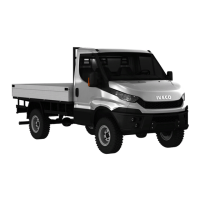26
DAILY 4x4 ‒ GUIDELINES FOR BODYBUILDERS
CHASSIS INTERVENTIONS
2.10 MODIFYING THE ENGINE AIR INTAKE AND EXHAUST SYSTEMS
– Printed 692.68.999 – 3 Ed. - Base 08-2020
In exceptional cases and for specific uses, the possibility may be evaluated of allowing the addition of extra leaf springs on the para-
bolic springs; this must be carried out by a specialised spring manufacturer after approval by IVECO.
It is not allowed to use a parabolic spring on one end of the axle and a semi-elliptic string on the other end.
▶ On vehicles equipped with an ESP system, modifications of the suspensions are not permitted.
See Chapter 2.15 - Paragraph "Derating of the ESP System".
Note
Adaptation of the suspension assumes a corresponding adaptation of the ESP system controlling stability (see Paragraph "Derating
of the ESP system" (
➠
Page 40)).
2.10 MODIFYING THE ENGINE AIR INTAKE AND EXHAUST SYSTEMS
Table 2.13 - Back pressure at nominal speed and full load
Engine Engine code Exhaust back pressure [kPa] Min - max vacuum on intake [kPa]
.18H VGT Euro VI F1CFL411W*E 40 1 - 9
.15H WG Euro III F1CE0489R*L 13 1 - 5
Note
Any interventions, if authorised by IVECO, must not vary the original intake vacuum and exhaust back pressure values.
2.10.1 Intake
The air intake must be mounted as to avoid intake of hot air from the engine compartment, or dust and water.
The intake compartment must be sealed airtight and fitted with rubber gaskets that prevent hot air recirculation. The gaskets must
be of high quality as to support a steady temperature of 100 °C, with short durations of 120 °C, without undergoing visible de-
formations or deteriorations. The compartment must keep airflow sections efficient for the entire circuit.
Any openings made in the box part of the van must have an area of approximately twice that of the cross-section of the pipe up-
stream of the filter. The protective grids must have a mesh with holes of maximum size 6 mm (to prevent the entry of foreign
bodies or cigarette butts) and a minimum size that does not allow blockages.
The following are not allowed:
● alterations or replacement of the original air filter with one of lower capacity;
● intervene on equipment (injection pump, regulator, injectors, etc.) that may compromise good engine performance and affect
exhaust gas emissions.
●
change the Humidity sensor → Blow-by sequence in the segment between the air filter and turbine.
Lastly, it is necessary to check if new system approval is required in relation to specific national standards (sound level, smokiness).

